Abstract
Foundation pit pumping induces groundwater drawdown both inside and outside the pit, consequently causing surrounding land subsidence. Based on actual engineering cases, this study established a three-dimensional numerical model using ABAQUS software (version 6.14-4) to systematically investigate the temporal evolution of groundwater drawdown and land subsidence during pit pumping, while quantifying the relationship between drawdown and subsidence stabilization time under different parameters. The key findings are as follows: (1) land subsidence stabilization time (50 days) is governed by external phreatic layer response, reaching 2.3 times longer than isolated aquifer conditions (22 days); (2) medium-permeability strata (0.01–10 K0,AdII) showed peak sensitivity to drawdown–subsidence coupling; (3) pumping from a confined aquifer extends the subsidence stabilization time by a factor of 1.1 compared to phreatic aquifer conditions. These findings provide valuable insights for the design and risk assessment of dewatering strategies in foundation pits within multi-aquifer systems.
1. Introduction
Foundation pit excavation, a common practice in urban engineering [1,2,3,4,5,6,7,8,9,10,11,12,13,14,15], often requires groundwater lowering through pumping to maintain dry working conditions [10,16,17,18,19,20,21,22,23,24,25,26,27,28]. However, the groundwater drawdown and associated land subsidence can have significant geological impacts [3,29,30,31,32,33,34,35,36]. Pumping alters groundwater flow patterns and redistributes subsurface stress, potentially threatening the stability of nearby underground infrastructure [37,38,39,40,41,42,43,44,45,46,47,48,49,50,51,52,53,54]. In addition, land subsidence may damage surrounding buildings, roads, and pipelines, posing serious safety risks [37,38,39,40,41,42,49,55,56,57,58,59,60,61,62,63]. Therefore, effective control of drawdown and subsidence during foundation pit pumping is crucial [29,30,31,32,33,34,35,36,56,58,64,65,66].
To better understand the environmental impact of foundation pit pumping [29,30,31,32,67,68,69,70,71,72,73], researchers commonly employ a combination of numerical simulations [27,39,42,65,74,75,76,77,78,79], theoretical analyses [5,17,80,81,82], and laboratory or analog experiments [9,79]. For example, Ping et al. [83] used numerical simulations to study land subsidence under varying pumping rates, filter pipe lengths, and waterproof curtain depths. Lyu et al. [17] established a theoretical framework to quantify foundation pit dewatering-induced subsidence. Wang et al. [27] developed a general conceptual model based on the Hangzhou Metro project to investigate the maximum excavation depth during pumping. However, existing studies have primarily focused on land subsidence at the end of pumping [6,10,11,22,51], with limited attention paid to its temporal evolution during the pumping process.
In coastal urban areas, complex leaky aquifer systems are widely distributed, characterized by alternating aquitards and aquifers [2,68,84,85,86,87]. During pumping tests, the hydraulic head difference between adjacent aquifers induces cross-flow through the aquitard, leading to more complex drawdown behavior and making it difficult to assess the stabilization time of ground subsidence [10,16,88,89,90]. Li et al. [5] quantified groundwater and deep soil responses to precipitation in multi-aquifer systems via coupled statistical numerical approaches, and Fan et al. [82] documented hydro-mechanical behavior in fully saturated sand strata during the Nantong Metro pumping tests. However, these studies primarily focus on soil deformation during the pumping process, without investigating the relationship between land subsidence and the stabilization time of water level drawdown.
To address this issue, this study established a three-dimensional numerical model using ABAQUS software based on actual foundation pit dewatering tests. The reliability of the model was verified by comparing the simulation results with measured data. On this basis, further parametric studies were conducted to investigate the relationship between groundwater drawdown and land subsidence from three perspectives: (1) hydraulic connectivity inside and outside the pit, (2) different site conditions, and (3) varying pumping well locations. Through this research, the authors aim to provide valuable insights and references for similar future projects, ensuring their safety, reliability, and sustainable development.
2. Engineering Background
Project Description
The foundation pit is located to the north of the intersection of Lingbin Road and Lingzhuozhi Road in Nankai District, Tianjin. The dimensions of the foundation pit are reported to be 155 m in length, 40 m in width, and 16.9 m in depth. The enclosure structure consists of a diaphragm wall with a thickness of 0.8 m and a depth of 32.5 m. According to the survey data, the soil quality of the site is primarily classified as silty clay, silt, and sandy silt [51,59,79,84]. The stratigraphic profile consists of five aquifers (Aq0–AqIV), separated by weakly permeable layers (AdI–AdIV), among which the soil thickness of Aq0–AqIV is 10.0 m, 4 m, 13.5 m, 4 m, and 3 m, respectively. The initial water levels of Aq0–AqIV were 2.0 m, 2.7 m, 3.0 m, 3.2 m, and 3.7 m, respectively. For a detailed distribution of typical soil layers and their mechanical parameters, one can refer to the article by Zeng et al. [6,7,8,9,10,51,52,53,54,67,68]. A series of observation points were arranged around the foundation pit. Considering the symmetry of the pit and the similarity of soil conditions in the north and south directions, this paper only shows the water level observation well arranged on the north side (as shown in Figure 1).
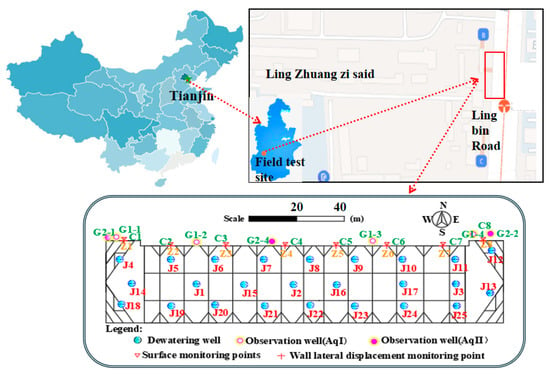
Figure 1.
Foundation pit location and monitoring point layout.
To assess the actual performance of the pumping wells and prevent excessive deformation of the foundation pit, the diaphragm wall system and primary strut supports were fully installed prior to the commencement of the pumping test. The test involved 22 pumping wells operating continuously for 3.2 days (77 h). After the test, the observation results showed that the water level inside the foundation pit dropped to a maximum depth of 15 m. Due to the hydraulic connection between the inside and outside of the pit, the water level of AqI and AqII decreased by about 3 m and 8 m. Notably, varying degrees of land subsidence were recorded at different monitoring points during the test, with the maximum settlement exceeding 10 mm.
These observations indicate that the impact of foundation pit pumping extends beyond groundwater level decline, involving complex patterns of soil subsidence. To gain a more comprehensive understanding of land subsidence induced by pumping, a detailed numerical analysis was conducted using ABAQUS.
3. Numerical Simulation and Verification
3.1. Model Establishment
To optimize computational efficiency while maintaining accuracy, the numerical model was developed using a half-section representation that capitalizes on the foundation pit’s symmetrical configuration (as shown in Figure 2). To eliminate boundary interference effects, the influence radius (R) of pumping was determined as 615 m according to the Sichardt formula [1]. During the simulation, the final drawdown of the water level in AqII was set to 35.5 m, with a hydraulic conductivity (K) of 3 m/d. Consequently, the overall model dimensions were set to 1440 m × 777.5 m × 50 m.
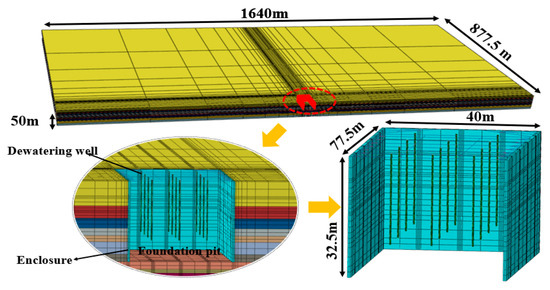
Figure 2.
Finite element model mesh diagram.
Given the elastic nature of the soil and fluctuating groundwater levels at the site, the Mohr–Coulomb model was selected to represent the soil behavior. The key model parameters are summarized in Figure 3. The elastic modulus was set to 30 GPa for the diaphragm wall and 210 GPa for the pumping wells. Referring to previous numerical studies, the friction coefficient between the soil and structures was set at 0.3. The simulations for the soil, diaphragm wall, and pumping wells employed C3D8P elements, C3D8I incompatible elements, and S4 shell elements, respectively [5,13,42,91,92,93,94,95,96,97,98,99].
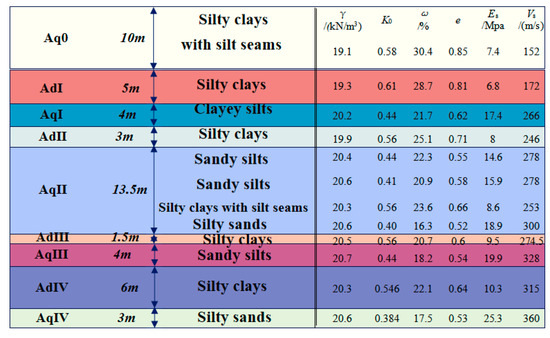
Figure 3.
Basic parameters of the finite element model.
In terms of model constraints, the bottom boundary was fixed in both the horizontal and vertical directions to prevent displacement; the lateral boundaries were horizontally restrained, with a constant-head boundary condition applied to simulate groundwater recharge. To simulate the waterless surface condition, the pore pressure at the top soil boundary was set to zero. The pumping effect was simulated by applying a head boundary condition to the soil surfaces in contact with the wells.
3.2. Model Verification
To assess the reliability and predictive capability of the numerical model, a comparative analysis was conducted between the simulated and observed groundwater drawdowns both inside and outside the foundation pit. Two representative time points were selected for evaluation: the mid-stage of pumping (37 h) and the end of pumping (3.2 days). As shown in Figure 4, the simulation results closely match the field measurements at both time points, demonstrating high accuracy. Additionally, the simulated surface subsidence after pumping was compared with observed values (Figure 5), showing only minor discrepancies. This indicates that the model effectively captures the ground deformation behavior. Overall, the validation results confirm that the numerical model reliably reproduces the coupled processes of groundwater drawdown and soil deformation in multi-layered aquifer systems under pumping conditions.
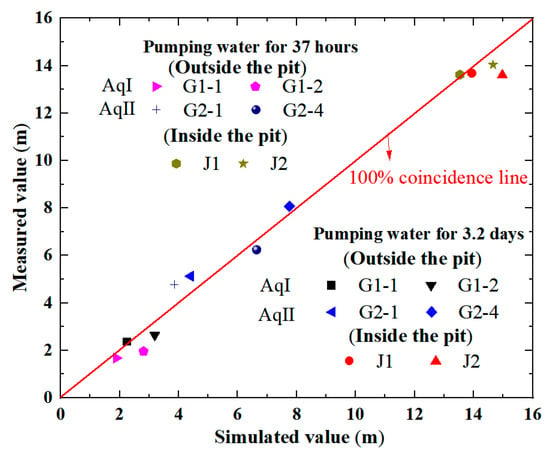
Figure 4.
Comparison of measured and simulated values of groundwater drawdown at different times (adapted from reference [10]).
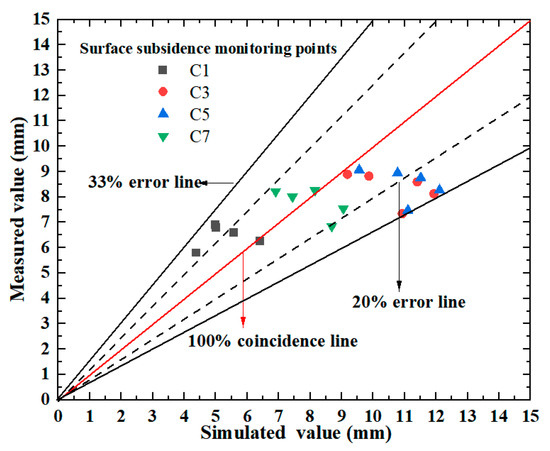
Figure 5.
Comparison of the measured and simulated values of land subsidence in the final state of pumping (adapted from reference [10]).
4. Evolution Mechanisms of Soil Deformation Induced by Foundation Pit Pumping
This study investigates the developmental relationship between land subsidence and groundwater drawdown during pumping processes in complex leaky aquifer systems under varying parametric conditions, with particular emphasis on evaluating the temporal correlation of their stabilization time. For precise assessment, monitoring point E′ (recording the maximum drawdown inside the excavation) and phreatic layer observation point A (external to the pit) were strategically selected. Land subsidence measurements were conducted at a monitoring station located 9 m from the excavation boundary. Continuous monitoring throughout the pumping duration enabled comprehensive analysis of three critical influencing factors: (1) pit-exterior hydraulic connectivity, (2) different site conditions, and (3) different pumping positions.
4.1. Influence of Pit-Exterior Hydraulic Connectivity
To simulate the scenario without hydraulic connectivity during pumping in the phreatic aquifer, the permeability coefficient of the AqII (depth range: 32.5–35.5 m) was reduced by a factor of 104.
Figure 6 illustrates the variations in groundwater drawdown under different hydraulic connectivity conditions. The monitoring results demonstrate significant differences in groundwater response patterns between the excavation interior (point E′) and exterior (point A). At the exterior monitoring point (point A), the phreatic water level exhibited a characteristic fluctuation pattern of initially rising, then declining, and finally rebounding, indicating potential delayed responses from deeper aquifers. In contrast, the interior point (point E′) displayed a continuous increase in drawdown magnitude with prolonged pumping time.

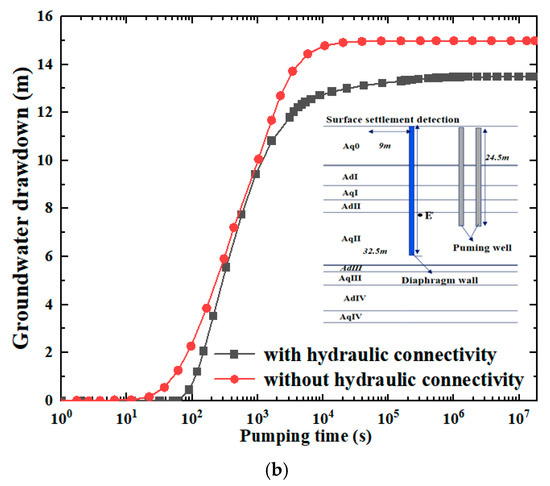
Figure 6.
Temporal evolution of groundwater drawdown under different hydraulic connectivity conditions: (a) point A; (b) point E′.
The stabilization time was significantly affected by hydraulic connectivity conditions: at point A, stabilization required 49 days under connected conditions compared to 22 days under isolated conditions, while point E′ required 3.3 days to reach stabilization under connected conditions, compared to only 0.23 days in isolated scenarios, highlighting hydraulic connectivity as a critical control factor. Furthermore, the results revealed an important inverse relationship between drawdown extent in the interior and exterior zones, with increased connectivity leading to greater drawdown extent outside the excavation and correspondingly smaller drawdown inside. This occurs because the second confined aquifer exhibits low permeability and the diaphragm wall completely isolates the aquifer, forcing pumping to rely solely on internal water release.
Figure 7 illustrates the variations in land subsidence outside the foundation pit under different hydraulic connectivity conditions. The monitoring data reveal a striking contrast in land subsidence behavior depending on the hydraulic connectivity conditions. When the excavation interior maintains hydraulic connection with the surrounding, the resulting land subsidence becomes substantially more pronounced compared to under disconnected conditions. The maximum subsidence with hydraulic connectivity reaches a value approximately three times greater than that observed in disconnected scenarios. This dramatic difference stems from several interconnected mechanisms. First, the established hydraulic connection facilitates broader propagation of pumping-induced depressurization through the groundwater flow regime. This extended influence allows pore water pressure reductions to affect more distant soil masses, triggering widespread consolidation settlements. Second, the prolonged stabilization period characteristic of connected systems—nearly double the duration required in isolated conditions—permits additional time-dependent deformation through soil creep processes. These combined effects explain the significantly amplified settlement magnitudes observed when hydraulic continuity exists across the excavation boundary.
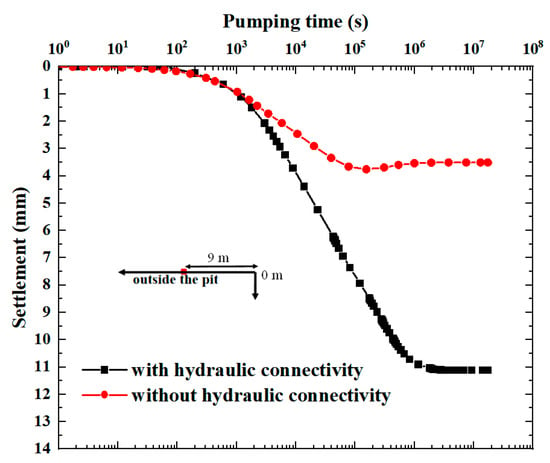
Figure 7.
The temporal evolution of land subsidence outside the foundation pit under different hydraulic connectivity conditions.
Further analysis reveals a critical relationship between hydraulic connectivity and settlement stabilization time. The measured stabilization time—50 days under hydraulically connected conditions, compared to 22 days for isolated systems—demonstrates that the ultimate subsidence stabilization time is predominantly controlled by the phreatic aquifer response outside the excavation, rather than by the maximum drawdown point within the pit. These results fundamentally shift the understanding of subsidence stabilization from a local excavation phenomenon to a system-wide hydraulic process, emphasizing the critical need for comprehensive aquifer monitoring beyond excavation boundaries in pumping projects. These findings provide new insights into the mechanisms of subsidence stabilization, emphasizing the critical need for comprehensive aquifer monitoring beyond excavation boundaries in pumping projects.
4.2. Influence of Different Site Conditions
To systematically investigate the evolution patterns of groundwater drawdown and land subsidence induced by foundation pit pumping under various hydrogeological conditions, this study employed a parametric analysis approach by conducting numerical simulations with multiple scenarios of permeability coefficients for the typical aquitard (AdIIlayer). The permeability coefficients were systematically varied as follows: 10−2 K0,AdII, 10−1 K0,AdII, 10 K0,AdII, and 100 K0,AdII, where K0,AdII is the conventional permeability coefficient of the soil layer. This parameter combination effectively covers typical working conditions ranging from nearly impermeable layers to highly permeable formations, enabling quantitative analysis of how aquifer connectivity affects the coupling mechanism between groundwater seepage fields and soil deformation.
Figure 8 illustrates the variations in groundwater drawdown under different site conditions. Simulated data indicate that improvements in site conditions (such as enhanced permeability coefficient) result in significantly greater drawdown at the external monitoring point (point A). This is primarily because the improved site conditions increase aquifer permeability, allowing external groundwater to recharge towards the foundation pit more rapidly. In contrast, the drawdown rate and maximum drawdown at the internal monitoring point (point E′) remain largely unchanged, as the groundwater level inside the pit is predominantly controlled directly by pumping wells, with its drawdown extent depending mainly on pumping intensity and showing relative insensitivity to site condition improvements.
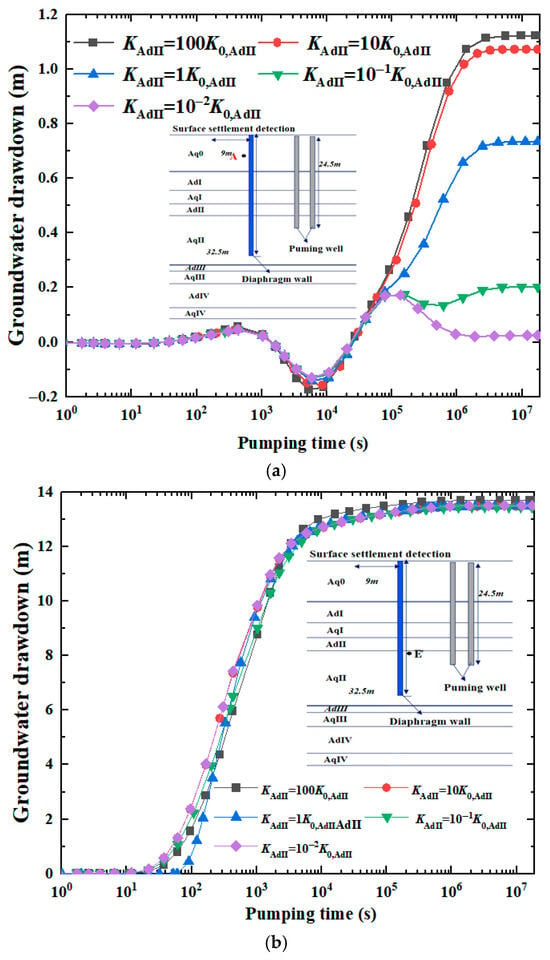
Figure 8.
The temporal evolution of groundwater drawdown under different site conditions: (a) point A; (b) point E′.
Furthermore, observations reveal that under various site conditions, the groundwater level inside the pit consistently remains higher than that outside. This phenomenon aligns with the typical characteristics of groundwater convergence toward the foundation pit, indicating that the dewatering system has established an effective hydraulic gradient. However, the stabilization time of the water level shows no clear correlation with site conditions, likely because the stabilization time is primarily governed by the overall water yield capacity of the aquifer and boundary conditions, which exhibit relatively limited variation across different site conditions.
Figure 9 illustrates the variations in land subsidence outside the foundation pit under different site conditions. Through the observational analysis, the following key patterns have been identified: as the permeability of the site increases, both the maximum land subsidence and its development rate show significant growth, a phenomenon consistent with the deformation characteristics of aquifer A. The results demonstrate that the land subsidence stabilization time is essentially synchronized with the stabilization time of water level drawdown at the external phreatic layer (point A). This synchronicity primarily occurs because subsidence is essentially a consolidation process of the aquifer system during water level decline, whose time-dependent behavior is coupled with the phreatic layer’s water level recovery dynamics. More importantly, within the medium permeability range (0.01 K0,AdII to 10 K0,AdII type soil layers), the drawdown of external water levels and the surface subsidence exhibit the most significant sensitivity, with the variation gradient reaching its peak value. This finding provides crucial guidance for construction control.

Figure 9.
The temporal evolution of land subsidence outside the foundation pit under different site conditions.
4.3. Influence of Different Pumping Position
To simulate different pumping scenarios, the water level in AqII was lowered by 20 m by pumping from the confined aquifer.
Figure 10 illustrates the variations in groundwater drawdown under different pumping conditions. Under confined aquifer pumping conditions, the external point A exhibited more pronounced water level fluctuations and a greater maximum drawdown magnitude, and required a longer stabilization period. In contrast, the internal point E′ demonstrated a faster water level decline rate and greater ultimate drawdown, yet achieved stabilization in a shorter time. This discrepancy reflects the distinct hydrogeological effects of confined aquifer pumping on the internal and external phreatic layers, where the internal point is more directly influenced by the confined aquifer pumping, while the external point shows a notably slower response. These findings provide important guidance for the design of dewatering schemes in deep foundation pits.

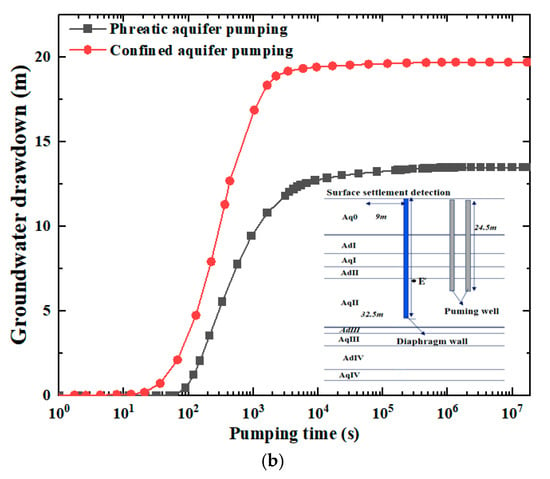
Figure 10.
The temporal evolution of groundwater drawdown under different pumping conditions: (a) point A; (b) point E′.
Figure 11 illustrates the variations in land subsidence outside the foundation pit under different pumping conditions. The observed difference in land subsidence behavior between confined aquifer pumping and phreatic layer pumping stems from their distinct hydrogeological mechanisms. When pumping from confined aquifers, the artesian pressure enables immediate stress transfer to overlying strata, causing rapid initial settlement. However, the low-permeability confining layers significantly hinder pore water dissipation, thereby extending the consolidation duration. Moreover, confined aquifer systems generally affect a broader zone with a greater compressible soil volume, necessitating more time to achieve complete equilibrium. This explains why the stabilization time for confined aquifer pumping is typically 1.1 times longer than that of phreatic layer pumping—the combination of rapid initial pressure release and subsequent slow drainage through multiple restrictive layers creates this characteristic pattern. In contrast, phreatic layer pumping exhibits slower initial settlement, but achieves stabilization more quickly, as water drains directly through higher-permeability materials without the impedance of confining layers. The extended stabilization period in confined systems reflects the more complex, multi-layer drainage process compared to the relatively straightforward drainage mechanism in unconfined aquifers.
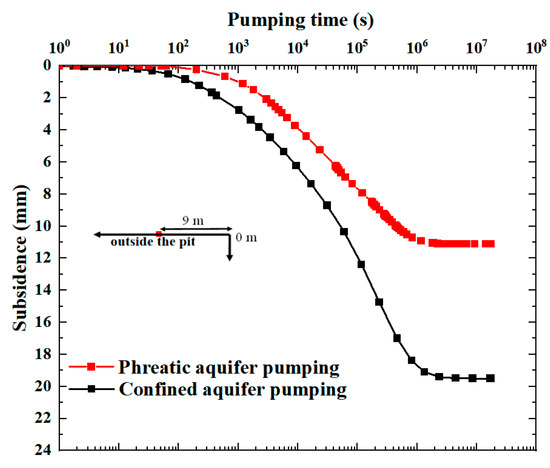
Figure 11.
The temporal evolution of land subsidence outside the foundation pit under different pumping conditions.
5. Conclusions
This study developed a three-dimensional numerical model using ABAQUS software based on actual dewatering projects to investigate the temporal relationship between groundwater level decline and land subsidence under various parameter conditions, with a particular focus on quantitatively analyzing the correlation between land subsidence stabilization time and drawdown stabilization time under different scenarios, including varying degrees of pit-external connectivity, site conditions, and pumping locations. The key findings are as follows:
- (1)
- The stabilization time of land subsidence is determined by the stabilization time of water level decline in the external phreatic layer. In practical engineering applications, continuous monitoring of pit deformation remains necessary even after internal water level stabilization, requiring sustained attention to the subsidence process of external water levels.
- (2)
- The study reveals distinct characteristics in water level responses inside and outside the excavation, demonstrating that both the rate and magnitude of drawdown within the pit are significantly greater than those in the external phreatic layer. This phenomenon reflects the disturbance effect of excavation on groundwater systems.
- (3)
- This study quantitatively analyzed the influence of hydraulic connectivity on pumping effects, revealing that enhanced connectivity accelerates internal water level decline while simultaneously exacerbating surface subsidence and prolonging its stabilization time.
From an engineering perspective, the findings suggest the importance of extended monitoring beyond pit boundaries in hydraulically connected systems, as external water level stabilization lags behind internal stabilization. Practitioners are advised to avoid prematurely ceasing monitoring before confirming stabilization in external phreatic layers. In addition, staged or reduced pumping rates may be considered in highly connected aquifers to mitigate excessive and prolonged settlement. These recommendations aim to enhance the safety and sustainability of dewatering strategies in similar projects.
Author Contributions
Conceptualization, J.C. and C.Z.; methodology, C.Z. and X.X.; software, S.W.; validation, Z.Z. and Y.Z.; formal analysis, J.C.; investigation, J.C. and S.W.; resources, C.Z.; data curation, J.C. and S.W.; writing—original draft preparation, J.C.; writing—review and editing, C.Z. and X.X.; visualization, Z.Z. and Y.Z.; supervision, Z.Z. and Y.Z.; project administration, C.Z.; funding acquisition, C.Z. All authors have read and agreed to the published version of the manuscript.
Funding
This work was supported by the National Natural Science Foundation of China [grant numbers 52478342], the Science and Technology Innovation Program of Hunan Province [grant number 2022RC1172].
Data Availability Statement
The original contributions presented in this study are included in the article. Further inquiries can be directed to the corresponding author.
Acknowledgments
The authors are grateful for the warm and efficient work by editors and reviewers.
Conflicts of Interest
Authors Youwu Zhao and Zirui Zhang were employed by the China Construction Fifth Engineering Division Corp. The remaining authors declare that the research was conducted in the absence of any commercial or financial relationships that could be construed as a potential conflict of interest.
References
- Biot, M.A. General Theory of Three-Dimensional Consolidation. J. Appl. Phys. 1941, 12, 155–164. [Google Scholar] [CrossRef]
- Zheng, G.; Ha, D.; Loaiciga, H.; Zhou, H.; Zeng, C.; Zhang, H. Estimation of the Hydraulic Parameters of Leaky Aquifers Based on Pumping Tests and Coupled Simulation/Optimization: Verification Using a Layered Aquifer in Tianjin, China. Hydrogeol. J. 2019, 27, 3081–3095. [Google Scholar] [CrossRef]
- Zheng, G.; Dai, X.; Diao, Y.; Zeng, C. Experimental and Simplified Model Study of the Development of Ground Settlement under Hazards Induced by Loss of Groundwater and Sand. Nat. Hazards 2016, 82, 1869–1893. [Google Scholar] [CrossRef]
- Bear, J. Hydraulics of Groundwater; Courier Corporation: Mineola, NY, USA, 2012. [Google Scholar]
- Li, M.-G.; Chen, J.-J.; Xia, X.-H.; Zhang, Y.-Q.; Wang, D.-F. Statistical and Hydro-Mechanical Coupling Analyses on Groundwater Drawdown and Soil Deformation Caused by Dewatering in a Multi-Aquifer-Aquitard System. J. Hydrol. 2020, 589, 125365. [Google Scholar] [CrossRef]
- Yang, K.; Xu, C.; Zeng, C.; Zhu, L.; Xue, X.; Han, L. Analysis of Recharge Efficiency Under Barrier Effects Incurred by Adjacent Underground Structures. Water 2025, 17, 257. [Google Scholar] [CrossRef]
- He, D.; Zeng, C.; Xu, C.; Xue, X.; Zhao, Y.; Han, L.; Sun, H. Barrier Effect of Existing Building Pile on the Responses of Groundwater and Soil During Foundation Pit Dewatering. Water 2024, 16, 2977. [Google Scholar] [CrossRef]
- Zeng, C.-F.; Chen, H.-B.; Liao, H.; Xue, X.-L.; Chen, Q.-N.; Diao, Y. Behaviours of Groundwater and Strata during Dewatering of Large-Scale Excavations with a Nearby Underground Barrier. J. Hydrol. 2023, 620, 129400. [Google Scholar] [CrossRef]
- Fan, Z.; Xu, C.; Yang, K.; Xue, X.; Zeng, C. Experimental Study on the Influence of Rising Water Levels on the Buoyancy of Building Structure. Water 2025, 17, 1377. [Google Scholar] [CrossRef]
- Zeng, C.-F.; Wang, S.; Xue, X.-L.; Zheng, G.; Mei, G.-X. Characteristics of Ground Settlement Due to Combined Actions of Groundwater Drawdown and Enclosure Wall Movement. Acta. Geotech. 2022, 17, 4095–4112. [Google Scholar] [CrossRef]
- Xue, T.; Xue, X.; Long, S.; Chen, Q.; Lu, S.; Zeng, C. Effect of Pre-Existing Underground Structures on Groundwater Flow and Strata Movement Induced by Dewatering and Excavation. Water 2023, 15, 814. [Google Scholar] [CrossRef]
- Yang, K.; Xu, C.; Chi, M.; Wang, P. Analytical Analysis of the Groundwater Drawdown Difference Induced by Foundation Pit Dewatering with a Suspended Waterproof Curtain. Appl. Sci. 2022, 12, 10301. [Google Scholar] [CrossRef]
- Yu, J.; Zhang, W.; Li, D. Analytical Solution for Steady-State Seepage Field of Foundation Pit During Water Curtain Leakage. Mathematics 2025, 13, 203. [Google Scholar] [CrossRef]
- Yang, T.L.; Yan, X.X.; Wang, H.M.; Huang, X.L.; Zhan, G.H. Comprehensive Experimental Study on Prevention of Land Subsidence Caused by Dewatering in Deep Foundation Pit with Hanging Waterproof Curtain. Proc. Int. Assoc. Hydrol. Sci. 2015, 372, 1–5. [Google Scholar] [CrossRef][Green Version]
- Xu, W.; Liu, B.; Wu, J. Construction Technology and Service Performance of Waterproof Curtain for Foundation Pit in Large-Particle Pebble Gravel Layer of Yangtze River Floodplain. Appl. Sci. 2024, 14, 5962. [Google Scholar] [CrossRef]
- Shen, S.-L.; Lyu, H.-M.; Zhou, A.; Lu, L.-H.; Li, G.; Hu, B.-B. Automatic Control of Groundwater Balance to Combat Dewatering during Construction of a Metro System. Autom. Constr. 2021, 123, 103536. [Google Scholar] [CrossRef]
- Lyu, H.-M.; Shen, S.-L.; Wu, Y.-X.; Zhou, A.-N. Calculation of Groundwater Head Distribution with a Close Barrier during Excavation Dewatering in Confined Aquifer. Geosci. Front. 2021, 12, 791–803. [Google Scholar] [CrossRef]
- Sun, W.; Liu, H.; Zhang, W.; Liu, S.; Han, L. Determination of Groundwater Buoyancy Reduction Coefficient in Clay: Model Tests, Numerical Simulations and Machine Learning Methods. Undergr. Space 2023, 13, 228–240. [Google Scholar] [CrossRef]
- Bevan, M.A.; Powrie, W.; Roberts, T.O.L. Influence of Large-Scale Inhomogeneities on a Construction Dewatering System in Chalk. Géotechnique 2010, 60, 635–649. [Google Scholar] [CrossRef]
- Forth, R.A. Groundwater and Geotechnical Aspects of Deep Excavations in Hong Kong. Eng. Geol. 2004, 72, 253–260. [Google Scholar] [CrossRef]
- Zeng, C.-F.; Zheng, G.; Xue, X.-L.; Mei, G.-X. Combined Recharge: A Method to Prevent Ground Settlement Induced by Redevelopment of Recharge Wells. J. Hydrol. 2019, 568, 1–11. [Google Scholar] [CrossRef]
- Zeng, C.-F.; Song, W.-W.; Xue, X.-L.; Li, M.-K.; Bai, N.; Mei, G.-X. Construction Dewatering in a Metro Station Incorporating Buttress Retaining Wall to Limit Ground Settlement: Insights from Experimental Modelling. Tunn. Undergr. Space Technol. 2021, 116, 104124. [Google Scholar] [CrossRef]
- Zeng, C.-F.; Powrie, W.; Xue, X.-L.; Li, M.-K.; Mei, G.-X. Effectiveness of a Buttress Wall in Reducing Retaining Wall Movement during Dewatering before Bulk Excavation. Acta Geotech. 2021, 16, 3253–3267. [Google Scholar] [CrossRef]
- Chu, Y.; Shi, J.; Ye, Z.; Liu, D. Dewatering Characteristics and Drawdown Prediction of Suspended Waterproof Curtain Foundation Pit in Soft Soil Areas. Buildings 2024, 14, 119. [Google Scholar] [CrossRef]
- Liu, L.; Lei, M.; Cao, C.; Shi, C. Dewatering Characteristics and Inflow Prediction of Deep Foundation Pits with Partial Penetrating Curtains in Sand and Gravel Strata. Water 2019, 11, 2182. [Google Scholar] [CrossRef]
- Wang, X.-W.; Yang, T.-L.; Xu, Y.-S.; Shen, S.-L. Evaluation of Optimized Depth of Waterproof Curtain to Mitigate Negative Impacts during Dewatering. J. Hydrol. 2019, 577, 123969. [Google Scholar] [CrossRef]
- Wang, J.; Liu, X.; Wu, Y.; Liu, S.; Wu, L.; Lou, R.; Lu, J.; Yin, Y. Field Experiment and Numerical Simulation of Coupling Non-Darcy Flow Caused by Curtain and Pumping Well in Foundation Pit Dewatering. J. Hydrol. 2017, 549, 277–293. [Google Scholar] [CrossRef]
- Zhenfang, L.; Dongming, G.; Yanbing, W.; Zenglin, Z. Technology Research of Large Underwater Ultra-Deep Curtain Grouting in Zhong-Guan Iron Ore. Procedia Eng. 2011, 26, 731–737. [Google Scholar] [CrossRef][Green Version]
- Robins, N.S.; Davies, J.; Cheney, C.; Tribe, E.L. Groundwater in a Water-Rich Environment: Wales, a Land of Plenty. Water Environ. J. 2005, 19, 62–67. [Google Scholar] [CrossRef]
- Luczaj, J.; Masarik, K. Groundwater Quantity and Quality Issues in a Water-Rich Region: Examples from Wisconsin, USA. Resources 2015, 4, 323–357. [Google Scholar] [CrossRef]
- Qu, S.; Shi, Z.; Liang, X.; Wang, G.; Han, J. Multiple Factors Control Groundwater Chemistry and Quality of Multi-Layer Groundwater System in Northwest China Coalfield—Using Self-Organizing Maps (SOM). J. Geochem. Explor. 2021, 227, 106795. [Google Scholar] [CrossRef]
- Li, D.; Cheng, S.; Liu, N.; Liu, Z.; Sun, Y. Numerical Simulation Study on the Distribution Characteristics of Precipitation Seepage Field in Water-Rich Ultra-Thick Sand and Gravel Layer. Water 2023, 15, 3720. [Google Scholar] [CrossRef]
- Luo, X.; Yu, C.; Wang, Y. Water Control of Water-Rich Deeply Buried Tunnel: An Analytical Model of a Combined Scheme. Geotech. Geol. Eng. 2023, 41, 3909–3922. [Google Scholar] [CrossRef]
- Wei, Z.; Zhu, Y. Seepage in Water-Rich Loess Tunnel Excavating Process and Grouting Control Effect. Geofluids 2021, 2021, 5597845. [Google Scholar] [CrossRef]
- Wang, Y.; Guo, P.; Lin, H.; Zhao, Y. Risk Management Technologies for Deep Excavations in Water-Rich Areas. Water 2024, 16, 323. [Google Scholar] [CrossRef]
- Wu, B.; Zhang, K.; Meng, G.; Suo, X. Optimization of Recharge Schemes for Deep Excavation in the Confined Water-Rich Stratum. Sustainability 2023, 15, 5432. [Google Scholar] [CrossRef]
- Yang, T.; Liu, S.; Wang, X.; Zhao, H.; Liu, Y.; Li, Y. Analysis of the Deformation Law of Deep and Large Foundation Pits in Soft Soil Areas. Front. Earth Sci. 2022, 10, 828354. [Google Scholar] [CrossRef]
- Zhao, J.; Tan, Z.; Yu, R.; Li, Z.; Zhang, X.; Zhu, P. Deformation Responses of the Foundation Pit Construction of the Urban Metro Station: A Case Study in Xiamen. Tunn. Undergr. Space Technol. 2022, 128, 104662. [Google Scholar] [CrossRef]
- Wang, Z. Numerical Analysis of Deformation Control of Deep Foundation Pit in Ulanqab City. Geotech. Geol. Eng. 2021, 39, 5325–5337. [Google Scholar] [CrossRef]
- Mei, Y.; Li, Y.-L.; Wang, X.-Y.; Wang, J.; Hu, C.-M. Statistical Analysis of Deformation Laws of Deep Foundation Pits in Collapsible Loess. Arab. J. Sci. Eng. 2019, 44, 8347–8360. [Google Scholar] [CrossRef]
- Wang, X.; Song, Q.; Gong, H. Research on Deformation Law of Deep Foundation Pit of Station in Core Region of Saturated Soft Loess Based on Monitoring. Adv. Civ. Eng. 2022, 2022, 7848152. [Google Scholar] [CrossRef]
- Zhou, N.; Vermeer, P.A.; Lou, R.; Tang, Y.; Jiang, S. Numerical Simulation of Deep Foundation Pit Dewatering and Optimization of Controlling Land Subsidence. Eng. Geol. 2010, 114, 251–260. [Google Scholar] [CrossRef]
- Wu, Y.-X.; Shen, S.-L.; Lyu, H.-M.; Zhou, A. Analyses of Leakage Effect of Waterproof Curtain during Excavation Dewatering. J. Hydrol. 2020, 583, 124582. [Google Scholar] [CrossRef]
- Huang, M.; Liu, X.; Zhang, N.; Shen, Q. Calculation of Foundation Pit Deformation Caused by Deep Excavation Considering Influence of Loading and Unloading. J. Cent. South Univ. 2017, 24, 2164–2171. [Google Scholar] [CrossRef]
- Tan, Y.; Wang, D. Characteristics of a Large-Scale Deep Foundation Pit Excavated by the Central-Island Technique in Shanghai Soft Clay. II: Top-Down Construction of the Peripheral Rectangular Pit. J. Geotech. Geoenviron. Eng. 2013, 139, 1894–1910. [Google Scholar] [CrossRef]
- Wang, S.; Li, Q.; Dong, J.; Wang, J.; Wang, M. Comparative Investigation on Deformation Monitoring and Numerical Simulation of the Deepest Excavation in Beijing. Bull. Eng. Geol. Environ. 2021, 80, 1233–1247. [Google Scholar] [CrossRef]
- Feng, Z.; Xu, Q.; Xu, X.; Tang, Q.; Li, X.; Liao, X. Deformation Characteristics of Soil Layers and Diaphragm Walls during Deep Foundation Pit Excavation: Simulation Verification and Parameter Analysis. Symmetry 2022, 14, 254. [Google Scholar] [CrossRef]
- Shi, H.; Jia, Z.; Wang, T.; Cheng, Z.; Zhang, D.; Bai, M.; Yu, K. Deformation Characteristics and Optimization Design for Large-Scale Deep and Circular Foundation Pit Partitioned Excavation in a Complex Environment. Buildings 2022, 12, 1292. [Google Scholar] [CrossRef]
- Cui, J.; Yang, Z.; Azzam, R. Field Measurement and Numerical Study on the Effects of Under-Excavation and Over-Excavation on Ultra-Deep Foundation Pit in Coastal Area. J. Mar. Sci. Eng. 2023, 11, 219. [Google Scholar] [CrossRef]
- Lin, P.; Liu, P.; Ankit, G.; Singh, Y.J. Deformation Monitoring Analysis and Numerical Simulation in a Deep Foundation Pit. Soil Mech. Found. Eng. 2021, 58, 56–62. [Google Scholar] [CrossRef]
- Zeng, C.-F.; Wang, S.; Xue, X.-L.; Zheng, G.; Mei, G.-X. Evolution of Deep Ground Settlement Subject to Groundwater Drawdown during Dewatering in a Multi-Layered Aquifer-Aquitard System: Insights from Numerical Modelling. J. Hydrol. 2021, 603, 127078. [Google Scholar] [CrossRef]
- Zeng, C.-F.; Powrie, W.; Chen, H.-B.; Wang, S.; Diao, Y.; Xue, X.-L. Ground Behavior Due to Dewatering Inside a Foundation Pit Considering the Barrier Effect of Preexisting Building Piles on Aquifer Flow. J. Geotech. Geoenviron. Eng. 2024, 150, 05024004. [Google Scholar] [CrossRef]
- Xue, X.-L.; Zhu, L.; Wang, S.; Chen, H.-B.; Zeng, C.-F. Groundwater Response to Pumping Considering Barrier Effect of Existing Underground Structure. In Proceedings of the 4th International Conference on Performance Based Design in Earthquake Geotechnical Engineering (Beijing 2022), Beijing, China, 15–17 July 2022. [Google Scholar]
- Zeng, C.F.; Sun, H.Y.; Chen, H.B.; Xue, X.L.; Liu, Y.S.; Song, W.W. Responses of Adjacent Building Pile to Foundation Pit Dewatering. In Proceedings of the 4th International Conference on Performance Based Design in Earthquake Geotechnical Engineering (Beijing 2022), Beijing, China, 15–17 July 2022; Wang, L., Zhang, J.M., Wang, R., Eds.; PBD-IV 2022. Geotechnical, Geological and Earthquake Engineering. Springer: Cham, Switzerland, 2022; Volume 52. [Google Scholar] [CrossRef]
- El-Nimr, M.T.; Basha, A.M.; Abo-Raya, M.M.; Zakaria, M.H. General Deformation Behavior of Deep Excavation Support Systems: A Review. Glob. J. Eng. Tech. Adv. 2022, 10, 39–57. [Google Scholar] [CrossRef]
- Wu, B.; Ge, C.; Li, P.; Yang, M.; Li, L. Influence of Deep Foundation Pit Excavation on Adjacent Pipelines: A Case Study in Nanjing, China. Appl. Sci. 2024, 14, 572. [Google Scholar] [CrossRef]
- Zhang, D. Influences of Deep Foundation Pit Excavation on the Stability of Adjacent Ancient Buildings. Buildings 2023, 13, 2004. [Google Scholar] [CrossRef]
- Li, D.; Liao, F.; Wang, L.; Lin, J.; Wang, J. Multi-Stage and Multi-Parameter Influence Analysis of Deep Foundation Pit Excavation on Surrounding Environment. Buildings 2024, 14, 297. [Google Scholar] [CrossRef]
- Zeng, F.-Y.; Zhang, Z.-J.; Wang, J.-H.; Li, M.-G. Observed Performance of Two Adjacent and Concurrently Excavated Deep Foundation Pits in Soft Clay. J. Perform. Constr. Facil. 2018, 32, 04018040. [Google Scholar] [CrossRef]
- Chen, G.; Zhang, X.; Zhang, S.; Huang, F.; Xiao, H.; Ma, H.; Luo, L.; Bao, H. Response Monitoring and Analysis in Deep Foundation Pit Excavation: A Case Study in Soft Soil at Subway Tunnel Intersections. Buildings 2023, 13, 1286. [Google Scholar] [CrossRef]
- Hu, B.; Li, X.; Huang, D. Safety Risk Analysis and Protective Control of Existing Pipelines Affected by Deep Pit Excavation in Metro Construction. Model. Simul. Eng. 2019, 2019, 3643808. [Google Scholar] [CrossRef]
- Li, G.; Qin, F.; Yan, N.; Qiao, X.; Si, L.; Zhao, S. Surface Deformation Characteristics and Influencing Factors in Deep Foundation Pit Excavations for Subway Projects in Ningbo’s Soft Soil Area. Buildings 2025, 15, 1229. [Google Scholar] [CrossRef]
- Yang, Y.; Li, X.; Chen, Y. The Influence of Different Excavation Methods on Deep Foundation Pit and Surrounding Environment. In Proceedings of the 8th International Conference on Civil Engineering, Nanchang, China, 4–5 December 2021. [Google Scholar]
- Ha, D.; Zheng, G.; Zhou, H.; Zeng, C.; Zhang, H. Estimation of Hydraulic Parameters from Pumping Tests in a Multiaquifer System. Undergr. Space 2020, 5, 210–222. [Google Scholar] [CrossRef]
- Wang, J.; Feng, B.; Yu, H.; Guo, T.; Yang, G.; Tang, J. Numerical Study of Dewatering in a Large Deep Foundation Pit. Environ. Earth Sci. 2013, 69, 863–872. [Google Scholar] [CrossRef]
- Zheng, G.; Ha, D.; Zeng, C.; Cheng, X.; Zhou, H.; Cao, J. Influence of the Opening Timing of Recharge Wells on Settlement Caused by Dewatering in Excavations. J. Hydrol. 2019, 573, 534–545. [Google Scholar] [CrossRef]
- Zeng, C.-F.; Zheng, G.; Xue, X.-L. Responses of Deep Soil Layers to Combined Recharge in a Leaky Aquifer. Eng. Geol. 2019, 260, 105263. [Google Scholar] [CrossRef]
- Zeng, C.-F.; Liao, H.; Xue, X.-L.; Long, S.-C.; Luo, G.-J.; Diao, Y.; Li, M.-G. Responses of Groundwater and Soil to Dewatering Considering the Barrier Effect of Adjacent Metro Station on Multi-Aquifers. J. Hydrol. 2022, 612, 128117. [Google Scholar] [CrossRef]
- Shen, L.; Xue, Z.; Tang, L.; Ge, H. Research on Resilience Evaluation and Enhancement of Deep Foundation Pit Construction Safety System. Buildings 2022, 12, 1922. [Google Scholar] [CrossRef]
- Rabiner, L.R.; Schafer, R.W. Theory and Applications of Digital Speech Processing, 1st ed.; Pearson Higher Education: Upper Saddle River, NJ, USA, 2011; ISBN 978-0-13-603428-5. [Google Scholar]
- Chang, Y.; Lv, L.; Wang, X.; Xu, J. A Semi-Analytical Solution of Two-Dimensional Unsteady Groundwater Flow Outside a Long-Strip Excavation Pit with a Cut-Off Wall. Appl. Sci. 2024, 14, 7367. [Google Scholar] [CrossRef]
- Zhang, Y.-Q.; Wang, J.-H.; Li, M.-G. Effect of Dewatering in a Confined Aquifer on Ground Settlement in Deep Excavations. Int. J. Geomech. 2018, 18, 04018120. [Google Scholar] [CrossRef]
- Wu, Y.-X.; Shen, J.S.; Cheng, W.-C.; Hino, T. Semi-Analytical Solution to Pumping Test Data with Barrier, Wellbore Storage, and Partial Penetration Effects. Eng. Geol. 2017, 226, 44–51. [Google Scholar] [CrossRef]
- Li, Q.; Cheng, F.; Zhang, X. Numerical Simulation and Deformation Prediction of Deep Pit Based on PSO-BP Neural Network Inversion of Soil Parameters. Sensors 2024, 24, 2959. [Google Scholar] [CrossRef] [PubMed]
- Liu, H.; Li, K.; Wang, J.; Cheng, C. Numerical Simulation of Deep Foundation Pit Construction under Complex Site Conditions. Adv. Civ. Eng. 2021, 2021, 6669466. [Google Scholar] [CrossRef]
- Zeng, C.-F.; Xue, X.-L.; Li, M.-K. Use of Cross Wall to Restrict Enclosure Movement during Dewatering inside a Metro Pit before Soil Excavation. Tunn. Undergr. Space Technol. 2021, 112, 103909. [Google Scholar] [CrossRef]
- Zeng, C.-F.; Xue, X.-L.; Zheng, G.; Xue, T.-Y.; Mei, G.-X. Responses of Retaining Wall and Surrounding Ground to Pre-Excavation Dewatering in an Alternated Multi-Aquifer-Aquitard System. J. Hydrol. 2018, 559, 609–626. [Google Scholar] [CrossRef]
- Zeng, C.-F.; Yuan, Z.-C.; Xue, X.-L.; Hu, W. Responses of Retaining Wall to Pre-Excavation Dewatering Under Staggered Layout of Dewatering Wells. In Proceedings of China-Europe Conference on Geotechnical Engineering, Vienna, Austria, 13–16 August 2018; Wu, W., Yu, H.-S., Eds.; Springer Series in Geomechanics and Geoengineering; Springer International Publishing: Cham, Switzerland, 2018; pp. 1085–1089. ISBN 978-3-319-97114-8. [Google Scholar]
- Zheng, G.; Zeng, C.-F.; Diao, Y.; Xue, X.-L. Test and Numerical Research on Wall Deflections Induced by Pre-Excavation Dewatering. Comput. Geotech. 2014, 62, 244–256. [Google Scholar] [CrossRef]
- Sethi, R. A Dual-Well Step Drawdown Method for the Estimation of Linear and Non-Linear Flow Parameters and Wellbore Skin Factor in Confined Aquifer Systems. J. Hydrol. 2011, 400, 187–194. [Google Scholar] [CrossRef]
- Zhang, R.; Zhang, W.; Goh, A.T.C.; Hou, Z.; Wang, W. A Simple Model for Ground Surface Settlement Induced by Braced Excavation Subjected to a Significant Groundwater Drawdown. Geomech. Eng. 2018, 16, 635–642. [Google Scholar] [CrossRef]
- Fan, D.; Tan, Y.; Tang, Y.; Wang, D. Evaluation of Dewatering-Induced Hydraulic and Ground Responses of Thick Multi-Aquifer Sandy Strata without Aquitards. Environ. Earth Sci. 2024, 83, 3. [Google Scholar] [CrossRef]
- Ping, S.; Wang, F.; Wang, D.; Li, S.; Yuan, Y.; Wu, M.; Pan, H.; Cao, Y. Optimization of a Deep Foundation Pit Dewatering Scheme in Gypsum-Bearing Strata. Environ. Earth Sci. 2024, 83, 8. [Google Scholar] [CrossRef]
- Xue, X.-L.; Sun, H.-Y.; Zeng, C.-F.; Chen, H.-B.; Zheng, G.; Xu, C.-J.; Han, L. Why Pile-Supported Building Settled Continuously after Water Level Was Stabilized during Dewatering: Clues from Interaction between Pile and Multi Aquifers. J. Hydrol. 2024, 638, 131539. [Google Scholar] [CrossRef]
- Zeng, C.-F.; Powrie, W.; Xu, C.-J.; Xue, X.-L. Wall Movement during Dewatering inside a Diaphragm Wall before Soil Excavation. Undergr. Space 2025, 22, 355–368. [Google Scholar] [CrossRef]
- Xie, Z.-F. Environmentally Sustainable Groundwater Control during Dewatering with Barriers: A Case Study in Shanghai. Undergr. Space 2021, 6, 12–23. [Google Scholar] [CrossRef]
- Wang, Z.-F.; Shen, S.-L.; Ho, C.-E.; Kim, Y.-H. Investigation of Field-Installation Effects of Horizontal Twin-Jet Grouting in Shanghai Soft Soil Deposits. Can. Geotech. J. 2013, 50, 288–297. [Google Scholar] [CrossRef]
- Sterling, S.N. Groundwater Lowering in Construction: A Practical Guide to Dewatering. Environ. Eng. Geosci. 2014, 20, 406–407. [Google Scholar] [CrossRef]
- Goh, A.T.C.; Zhang, R.H.; Wang, W.; Wang, L.; Liu, H.L.; Zhang, W.G. Numerical Study of the Effects of Groundwater Drawdown on Ground Settlement for Excavation in Residual Soils. Acta Geotech. 2020, 15, 1259–1272. [Google Scholar] [CrossRef]
- Zeng, C.-F.; Zheng, G.; Zhou, X.-F.; Xue, X.-L.; Zhou, H.-Z. Behaviours of Wall and Soil during Pre-Excavation Dewatering under Different Foundation Pit Widths. Comput. Geotech. 2019, 115, 103169. [Google Scholar] [CrossRef]
- Lu, D.; Meng, F.; Zhou, X.; Zhuo, Y.; Gao, Z.; Du, X. A Dynamic Elastoplastic Model of Concrete Based on a Modeling Method with Environmental Factors as Constitutive Variables. J. Eng. Mech. 2023, 149, 04023102. [Google Scholar] [CrossRef]
- Lu, D.; Wang, G.; Du, X.; Wang, Y. A Nonlinear Dynamic Uniaxial Strength Criterion That Considers the Ultimate Dynamic Strength of Concrete. Int. J. Impact Eng. 2017, 103, 124–137. [Google Scholar] [CrossRef]
- Lu, D.; Meng, F.; Zhou, X.; Wang, G.; Du, X. Double Scalar Variables Plastic-Damage Model for Concrete. J. Eng. Mech. 2022, 148, 04021143. [Google Scholar] [CrossRef]
- Lu, D.; Zhou, X.; Du, X.; Wang, G.S. 3D Dynamic Elastoplastic Constitutive Model of Concrete within the Framework of Rate-Dependent Consistency Condition. J. Eng. Mech. 2020, 146, 04020124. [Google Scholar] [CrossRef]
- Lu, D.; Zhou, X.; Du, X.; Wang, G. A 3D Fractional Elastoplastic Constitutive Model for Concrete Material. Int. J. Solids Struct. 2019, 165, 160–175. [Google Scholar] [CrossRef]
- Zhou, X.; Lu, D.H.; Zhang, Y.N.; Du, X.L. An Open-Source Unconstrained Stress Updating Algorithm for the modified Cam-clay model. Comput. Methods Appl. Mech. Eng. 2022, 390, 114356. [Google Scholar] [CrossRef]
- Yu, J.; Yao, W.; Duan, K.; Liu, X.Y.; Zhu, Y.L. Experimental Study and Discrete Element Method Modeling of Compression. Int. J. Rock Mech. Min. Sci. 2020, 134, 104437. [Google Scholar] [CrossRef]
- Lu, D.; Liang, J.; Du, X.; Ma, C.; Gao, Z. Fractional Elastoplastic Constitutive Model for Soils Based on a Novel 3D. Comput. Geotech. 2019, 105, 277–290. [Google Scholar] [CrossRef]
- Yu, J.; Zhu, Y.; Yao, Y.; Liu, X.; Ren, C.; Cai, Y.; Tang, X. Stress Relaxation Behaviour of Marble under Cyclic Weak Disturbance and confining pressures. Measurement 2021, 182, 109777. [Google Scholar] [CrossRef]
Disclaimer/Publisher’s Note: The statements, opinions and data contained in all publications are solely those of the individual author(s) and contributor(s) and not of MDPI and/or the editor(s). MDPI and/or the editor(s) disclaim responsibility for any injury to people or property resulting from any ideas, methods, instructions or products referred to in the content. |
© 2025 by the authors. Licensee MDPI, Basel, Switzerland. This article is an open access article distributed under the terms and conditions of the Creative Commons Attribution (CC BY) license (https://creativecommons.org/licenses/by/4.0/).